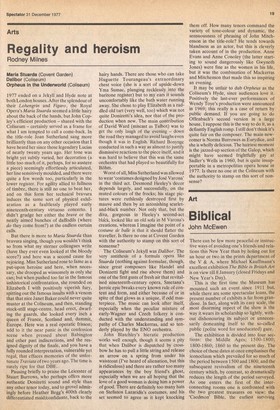Art
Biblical
John McEwen
There can be few more peaceful or instructive ways of avoiding one's friends and relations this New Year than by holing out for an hour or two in the prints department of the V & A, where Michael Kauffmann's excellent exhibition The Bible in British Art is on view till 8 January (closed Fridays and New Year's Day).
This is the first time the Museum has mounted such an event since 1911 but, while there are some spectacular loans, the present number of exhibits is far from grandiose. In fact, along with its easy scale, the most disarming aspect of the show is the way it wears its scholarship so lightly, without dishonouring its subject or unnecessarily demeaning itself to the so-called public (polite word for uneducated) gaze.
The exhibition is divided into four sections: the Middle Ages; 1500-1800;, 1800-1860; 1860 to the present day. The choice of these dates at once emphasises the iconoclasm which prevailed for so much of the period between 1500 and 1800, and the subsequent revivalism of the nineteenth century which, by contrast, so dramatically reduces the length of the period surveyed. As one enters the first of the interconnecting rooms one is confronted with the two greatest treasures on view: the `Caedmon' Bible, the earliest surviving English manuscript to contain an extensive series of Old Testament illustrations; and the 'Bible' of the Rochester Cathedral Priory. The 'Caedmon', dating from c. 1000, is Anglo-Saxon. Its illustrations are linear and only edged with colour, the drapery animating the figures. The Ark depicted is a Viking ship, an instance of the naturalism that often makes these devotional images a mine of socio-historical fact. All such illustrations, then as now, were probably done by commissioned lay artists. The monks only wrote the script. Opposite the 'Caedmon', the Rochester Bible c. 1130, is a dazzling example of the Romanesque style. The colour is richly inlaid, linearity is subect to mass. Till the gothic these were the dominating styles, though echoes of both re-appear later in the exhibition, notably in the work of William Blake. The Middle Ages saw the typological interpretation of the Old Testament in terms of the New well established; the 'Apocalypse' accepted as a theme, largely no doubt because of its pictorial appeal; and the English invention of the Psalter, to be replaced from the late fourteenth century by the Book of Hours. On the one hand decorative borders begin to swamp the pictures as artists vied for the attention of individual patrons, while on the other John Wycliffe introduced the first English translation of the Bible c. 1415-30, ominously lacking illustrations because of the hostility of the Lollards. From 1500 on the printing press totally supersedes the scribes, and the vernacular finally destroys the singular power of the priest versed in Latin. Engravings persist for a while, but no illustrated Bible appears for a hundred years and Thornhill's paintings round the dome of St Paul's, begun in 1714, are the first examples of church decoration in England since the reign of Henry VIII.
This break is the dramatic point of the exhibition. Biblically inspired illustration having been the prerogative of the Latin countries during our iconoclastic period, the latter half of the eighteenth century sees English artists catching up with the classicism of Raphael (a rare chance to see Reynolds's 'Holy Family', now relegated to the vaults because of its bituminous condition) and the sublimity of Salvator Rosa. The 'Apocalypse' is once again in favour and with romanticism comes a vogue for the 'Deluge'. Blake, of course, is the dominating artist of the period (well represented here) followed closely, chronologically, by Turner. Again judicious and amusing crossreferences are made between the staginess of de Loutherbourg, the naturalism of Turner and the cinematic extravaganzas of John Martin, who really was to be influential in early Hollywood. Martin's imaginative excesses were brought sharply to a halt by the topographic accuracies induced by travel and the Victorian taste for science. It is worth looking out for a fine painting by that good Scots artist Dyce in this section; and in the dying fall into our own illustratively benighted times, for the wood engravings of Millais, the pen drawings of Leighton (respectively some of the best work they ever did) and the abstract inventiveness of Paul Nash.
Overall the exhibition also hints at the inspiration of the Bible to potters, stained glass makers, sculptors and so on, but without extending the inquiry into confusion. If the progress from holy texts, via increasingly subjective pictures to some modern Punch cartoons seems a somewhat broad interpretation of the exhibition's title, it should also be remembered that in doing so it graphically marks a decline in faith but also, perhaps, an extension of charity.







































 Previous page
Previous page